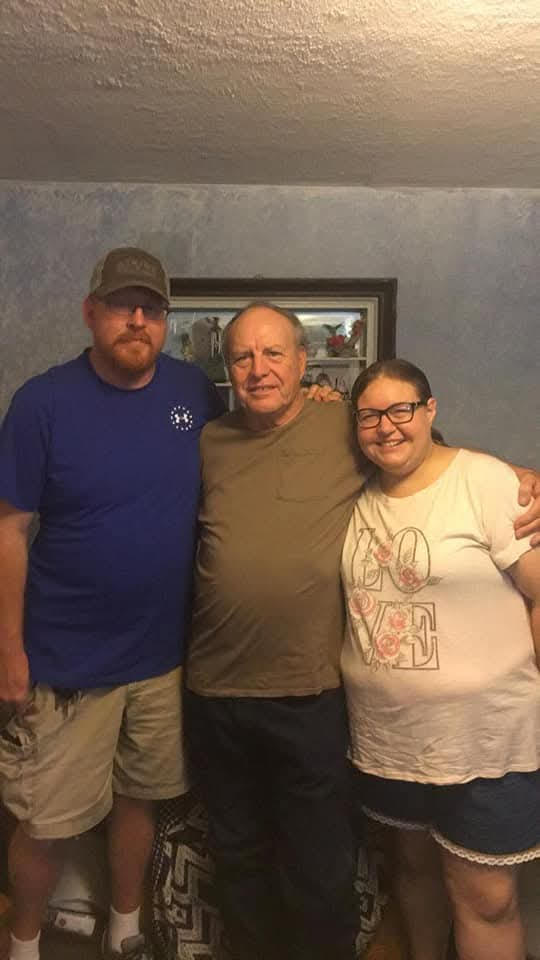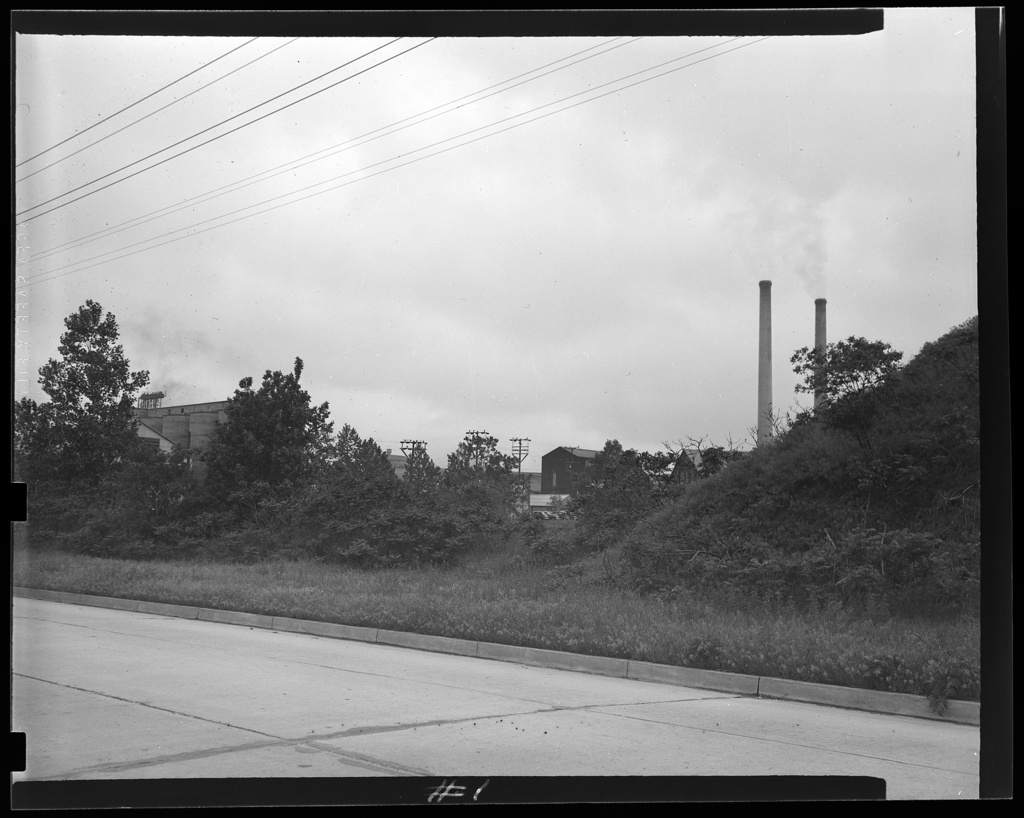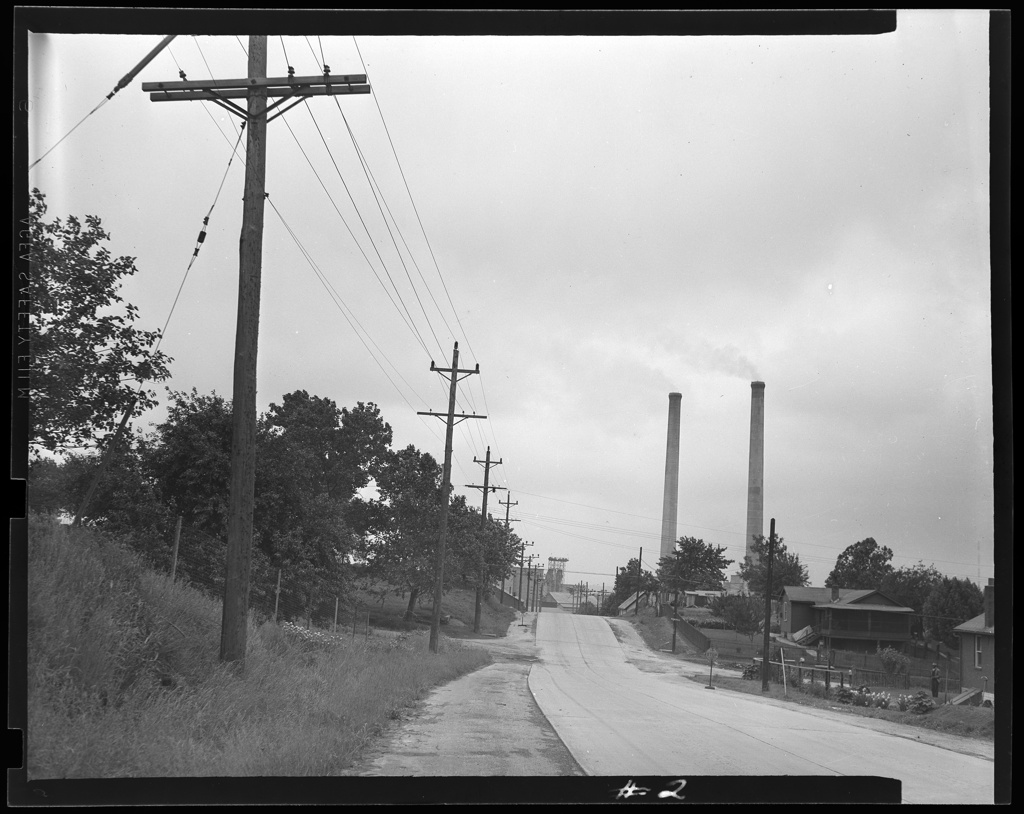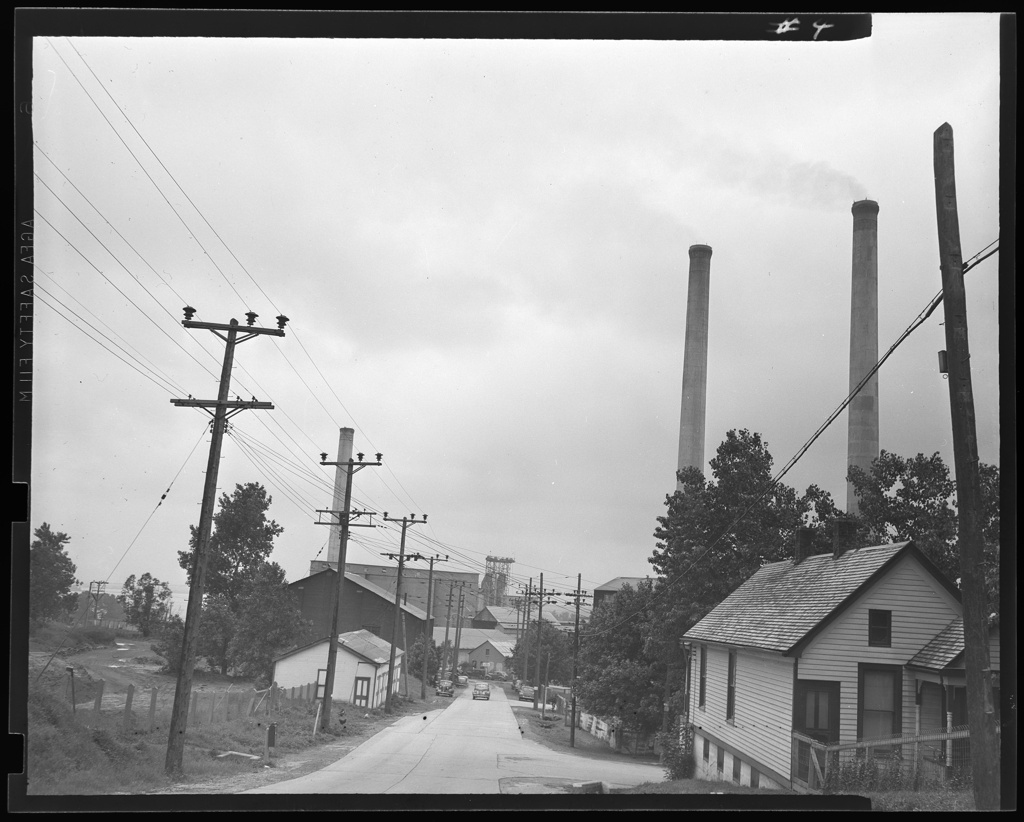Interview with Lonny Boring, Great Rivers Greenway, 2025
NO ALTERATION
06.25.25
Coffestamp, St. Louis, MO

Lonny Boring is a Senior Project Manager at Great Rivers Greenway, a local public agency planning to connect two greenway trails next to Cementland.
Danya:
Can you talk a bit about yourself and your role at Great Rivers Greenway?
Lonny Boring:
I've been working at Great Rivers Greenway since about 2008, and I'm a project manager in a division called the Build Team. We're a group of individuals that are responsible for helping plan, design, and construct new greenways, parks, and trails around the St. Louis Region. It's a great organization. I really enjoy working at Great Rivers Greenway because we get to create these fabulous places that welcome people into our natural world, connect us to new places around town, give us new ways to get around, and promote healthy lifestyles. So it suits me very well.
Danya:
And what’s a greenway?
Lonny Boring:
It's largely a linear park or trail system that goes from point A to point B, and it often includes other amenities beyond just a walking or biking trail. Sometimes it has restrooms, drinking fountains, park benches, lots of beautiful landscape. We like to use a lot of native plants to make it a welcoming and comfortable environment. We're always thinking about the user experience when we're connecting greenways. They are really a connection between people and places.
Danya:
How does Great Rivers Greenway choose where to develop greenways? What makes a good greenway location?
Lonny Boring:
All of our work has a foundation in community engagement, and that goes back to our enabling efforts. We're turning 25 years old this year, and our very first master plan laid the groundwork for the greenways throughout our three-county region [encompassing St. Louis City, St. Louis County, and Jefferson County]. It was a community driven plan, where we did a lot of open houses and listening sessions. And that plan is updated every four to six years. We always want to stay grounded in our community, what the desires are at the present, where those destinations are that people want to go to, and what they would like to see along the greenway.
Danya:
Does adaptive reuse often come into play when you are considering specific areas for development? Does Great Rivers Greenway typically work alongside existing infrastructure or natural features?
Lonny Boring:
All of the above, really. Our framework, the River Ring plan, outlines the major greenways. Then we dive into a more localized effort, and we conduct what's called a greenway master plan. We hire a team of consultants and engagement staff to help us analyze the physical conditions out there. We look for opportunities along creeks, existing parks, maybe an old rail corridor or in a power line corridor—things that could create these linear connections. It's a process where we are both listening to community desires and also have experts helping us find feasible routes. Then we present those options back to the community and see which one is preferred and gels with everyone. And it has to be feasible. Sometimes we do hit roadblocks, and we have to take a step back and reanalyze our options.

Danya:
Great Rivers Greenway is planning to connect the North Riverfront Trail to the Maline Creek Trail along Scranton Ave on the northern edge of Cementland. Can you talk about those two trails and the history of their development?
Lonny Boring:
The North Riverfront Trail actually predates Great Rivers Greenway. It was an early effort by Trailnet, [a biking advocacy nonprofit,] before Great Rivers Greenway was established in 2000. It's a long linear trail going from the Chain of Rocks Park all the way to downtown St. Louis along a really industrial, working riverfront with a lot of greenery, businesses, and other cement manufacturers. And when Great Rivers Greenway was established, we tried to upgrade it a little bit and improve it. It's an active levee road, so it has to function for all the industrial users along the Riverfront Trail. But it also needs to be safe and welcoming for the Greenway users. It's especially popular with long distance commuters and folks looking for long rides, because it has such a continuous corridor.
It does occasionally go underwater. And after the flood waters recede, there's often a cleanup and restoration effort. The Mississippi transports a lot of sediment, so you're often dealing with that sediment that's left behind as the waters recede. But by having that green space along the Mississippi, you give the river a little breathing room to fluctuate. You're not endangering personal property if you have park space and greenways along rivers. So it does provide a good buffer for that flood zone.
The Maline Greenway was identified in our original River Ring master plan. It's envisioned to go from the Mississippi River west, connecting multiple communities. There are many amazing parks along Maline Creek, and its western terminus is the St. Vincent Greenway, not too far from University of Missouri–St. Louis (UMSL) and NorthPark. So it would be connected on both ends with other greenways, and with all these great destinations and amazing communities in between.
I was involved in Maline Greenway's planning effort a long time ago. Back in 2010, we hired some consultants—landscape architects, engineers, and also engagement professionals—to help us go out to each of the communities along the planned Maline Greenway and identify the parks folks want to stop at along the way. It took about two years where we constantly listened and refined our options. And then in 2012, the Great Rivers Greenway Board of Directors adopted the Maline Greenway Plan, creating a loose blueprint for the Maline Greenway.
The city of Bellefontaine Neighbors had some roadway improvements on St Cyr Rd, so we were collaborating with the local community there to make sure that when they did those roadway improvements, they maintained space for the greenway connection. We provided financial support to some of their roadway projects so they could acquire extra right of way, so that when we got ready to implement the greenway through there, there would be some physical space for it to occupy.
We always saw Cementland as a unique destination on the eastern end of the Maline Greenway. We reached out to them, but we didn't have a lot of direct contact with Bob Cassilly or his staff. We always planned to be adjacent to Cementland, but didn't envision too many direct connections, unless they would happen more organically as the Greenway progressed.
Danya:
What effect will connecting the two greenways have in that area?
Lonny Boring:
The Maline Greenway will be an amazing connection through North County. Not many know there are multiple beautiful parks providing flood mitigation for Maline Creek. The greenway will connect to each of those parks and the communities around there. It connects to UMSL and NorthPark, an employment center. It goes right through downtown Ferguson near Plaza 501—their community space bringing people together with farmers markets and the Ferguson Twilight Run. It connects to the Ted Jones Trail, an old rail corridor originally organized by Trailnet. And then it goes through all the communities to the east and their parks, like Forestwood Park and Bellefontaine Neighbors Park, which is a hidden gem and very spacious.
Danya:
What are the next steps for Maline Greenway?
Lonny Boring:
Once we have a master plan at the greenway level, we break it down into projects and try to connect reasonable destinations. One of the early projects that we started to study after the master plan in 2012 was a connection from downtown Ferguson at Plaza 501 to Forestwood Park, which is just to the east. And the Ted Jones Trail is in the middle of those two.
It's a very challenging and tight corridor. It does follow Maline Creek for a short distance, but there are some challenging railroads and underground Metropolitan St. Louis Sewer District infrastructure. So it's taken a long time to come up with the best design there through our community engagement and technical analysis. But that's a project that will hopefully begin construction in the not too distant future.
We also have some other projects in the works a little farther to the east. Previously, we've already worked with St. Louis County Parks to upgrade some of the trails in their facilities. We worked on their bridges, which were very narrow, prepping them to become the backbone of the Maline Greenway.

Danya:
The planned segment of Maline Greenway on Scranton would pass between Cementland, which is now owned by Beelman Trucking, and a Metropolitan St. Louis Sewer District (MSD) facility on the other side. Would you be directly collaborating with both of those entities?
Lonny Boring:
Absolutely. We always want to talk to our neighbors. Great Rivers Greenway does not have any power of eminent domain. We have to work with willing parties and in locations where the community really wants to see this greenway investment. We have a large area in which we service for greenways, and we have greater success when we work in communities that are really identifying with our developments and seeking our improvements. So yes, any neighbor—MSD, corporations, whether industrial or commercial, regular homeowners and neighbors—we have to work and collaborate with everyone.
Danya:
How exactly do you engage homeowners? There is a cul-de-sac by Cementland across Scranton. Did you already engage those folks when you were crafting the master plan?
Lonny Boring:
Great question. In the greenway master planning process, we create a buffer around where we think the greenway might be feasible and we collect those addresses. We might begin by working with our engagement specialists, sending letters or mailers, making sure that folks are aware that we might host an open house or a town hall. We give them our contact information and try to get their interest in the greenway, either positive or negative.
Sometimes those letters and mailers aren't really effective, so we try to use social channels as well. Online surveys are becoming more and more effective. Within our organization, we have a great team of individuals who focus on community engagement, and they're really great at their craft. So if they aren't getting great feedback through one channel, they might try something else. Each community is slightly different, so you have to find what's working there. Once we get them connected, that conversation lasts for years as we continue the planning and studies. It takes several years to design a greenway.
The other tool that we often use is finding individuals who are leaders in their community—maybe shop owners or people who have other nonprofit organizations. They have great connections out to the community. We pull those individuals together into what we call a Community Advisory Committee. And we meet with them frequently, trying to make sure that we provide information and options to them. It's kind of a circular process. We ask, "What are the features you want to see? What are the destinations you want to see?" We go back to the drawing board, work with our engineers and landscape architects, try to interpret that, and then we present it back to them. It's an iterative process, and we use those Community Advisory Committees to help amplify and connect us to the community, because not everyone has time to come out to an open house. Maybe they have challenges with their work schedule or other things.
Danya:
The Scranton side of Cementland has been a big illegal dumping spot for years. Is there any research or anecdotal evidence as to whether greenways can deter trash dumping?
Lonny Boring:
I can't speak to that directly, but I would say that in general, the greenways welcome people to recreate or to commute through these areas, and so you're bringing more people there. And those people are out enjoying and appreciating the greenway; they want to care for it. So if those individuals see activity that shouldn't be occurring, like illegal dumping, they're going to report it more and make those people who are dumping or doing illegal activity more uncomfortable. They're bringing heightened awareness. Oftentimes, those types of activities operate in the shadows, and by inviting people adjacent to or along those areas, they're no longer spaces that are in the shadows. People are watching and actively caring for them.
Danya:
Your website says that Great Rivers Greenway is mindful of potential unintended negative consequences of greenway development like gentrification and displacement. So what steps does Great Rivers Greenway take to prevent those negative consequences?
Lonny Boring:
That's a great question. Also a tough question, because there are so many market forces out there that drive shifts in communities. I would say that what we try to do first and foremost is listen to the community. Make sure that those neighbors that are there now are the ones helping guide the design for the project, so that once the greenway is established, they want to stay there, keep investing, and really reap the benefits of those greenway improvements.
Our organization doesn't have political tools or ordinances that we can enact though. But we can work with our underlying municipal partners to try to think of ways that might keep those negative unintended consequences from happening. I think it's a multi-pronged approach that is challenging, but it's one we definitely have our eye toward. We try to listen to the community so they can help us identify what those unintended consequences might be for them.
Danya:
One direct anticipated effect of greenway development your website acknowledges is increasing property values in adjacent areas. Are you aware of any particular strategies that either Great Rivers Greenway or greenway developers in other regions implement to curb the impact of this property value increase on renters?
Lonny Boring:
None that I'm familiar with along the Maline Greenway, but I'll give you another example. We're currently working on the Brickline Greenway, which is an urban system meant to connect the four major parks in St. Louis: Forest Park to Gateway Arch and Fairground Park to Tower Grove Park. One of our projects for a segment of this greenway in North St. Louis City actually spawned a community development corporation, which will bring together and centralize some resources that were more siloed before. So affordable housing folks, as well as partners with other areas of expertise, come into the community development corporation, this central hub, so they can all be more collaborative. And I think that might be a model for future things in other areas. That effort is led by Chris Peoples, our Equity + Economic Impact Director.
So that's one idea that we're trying in that area of North St. Louis that has been disinvested for so long, because we're mindful of those potential negative effects. And the neighboring Central Corridor in St. Louis has a lot of economic change happening already. The segment we call the North Connector, which goes from St. Louis University north to Fairground Park, passes through Covenant Blu / Grand Center neighborhood, Jeff-Vander-Lou, and others. We work very closely with those communities' neighborhood organizations, and all of those have become members of this Brickline North Community Development Corporation.
Danya:
Are there both positive and negative cases of greenway development in other regions that Great Rivers Greenway looks at?
Lonny Boring:
Absolutely. We are always looking at our peers around the country for best practices, what's working, what's not. The Beltline in Atlanta is an example that comes to my mind. Atlanta is a city that's growing far more rapidly population wise than St. Louis. And the Beltline has had significant impacts on property values and other things in many of the neighborhoods, simply because folks are moving there, so there's a great demand for housing and commercial activities there.
We're also a member of what's called the High Line Network. The High Line in New York City had very similar types of things happening. Obviously, New York is huge, growing fast, and very unaffordable. And so they've identified these negative consequences also, and they host regular conversations with organizations across the country and try to help share tools and resources— what works from the development side, but also how we can work with the community to make sure our investments are benefiting those who are there today.
Danya:
As St. Louis City is actually losing population unlike Atlanta or New York, does that demographic trend alone prevent some of the more rampant gentrification effects that greenways have in those other regions?
Lonny Boring:
My personal opinion is that the slow growth of this region does tamp down gentrification, simply because we don't have a huge influx of new people moving to the area. It's more of a shuffling of people that are already here. They're moving to different places within our metropolitan area. I'm not saying that gentrification doesn't exist though. I see it happening in some neighborhoods, but it does seem to happen more slowly here because of our slow overall growth.
Danya:
Do you see any potential risk of gentrification in Riverview and Bellefontaine Neighbors along the Maline Greenway?
Lonny Boring:
In my opinion, it's a lower risk area. It's a little farther. It's a beautiful area, great views of the Mississippi, highly desirable if you want that more exurban type of environment. But it's not highly dense in nature. I often attribute gentrification to areas where you have a lot of commercial activity and hubs of transit. And this area near Cementland is more residential and has more of an exurban feel.
Danya:
I recently read about the Capital Improvement Plan in Raleigh, North Carolina. It was an early example of greenway planning going back to the 1960s. It envisioned greenways as connectors between homes, parks, and commercial destinations on one hand, but also as buffers designed to divide neighborhoods on the other. Can you talk about how Great Rivers Greenway’s planning is different from this older garden city type idea of using green open spaces as borders?
Lonny Boring:
Interesting question. Great Rivers Greenway operates in a region that's highly divided politically. We are fragmented by design. We have over a hundred municipalities within our jurisdictional area of St. Louis City, St. Louis County, and St. Charles County. And because we're a regional organization, we are the ones who try to transcend those boundaries and get folks talking and working together.
We don't want to be a divider between one community and the next. My goal, and I would say our goal, is to connect those places, because it's through this greater appreciation of our neighbors and other destinations in our city that we will become more prosperous together. That's my view, but that's how we operate too. Over the years, we've had hundreds of partners throughout the region, both municipalities and local organizations. We try to be the central location that folks can come to in order to collaborate and break down some of those artificial barriers that were established in the 60's and before to create segregation and separation.
Danya:
Great Rivers Greenway’s work is funded through sales taxes. From what I saw at a glance, most publicly funded greenways in other regions rely on a property tax instead. Do you see any significance to this difference, and does it affect Great Rivers Greenway’s work in any way?
Lonny Boring:
You're correct. Our funding is through two sales taxes: 1/10th and 3/16ths of one cent are the two values. I'm not an expert here, but from my perspective, it's because the state of Missouri largely uses sales taxes rather than property taxes. We have very low property taxes statewide, and in our region, it's really the sales tax that drives a lot of the governmental organizations in our communities. So we are just built on a model of the state of Missouri that existed before.
Things like groceries and pharmacies aren't subject to our tax. And those taxes collect a revenue, but it's split between us and the underlying municipality or county. So we see a portion of it to create this vision for a regional trail, but then each local community is benefiting from this collection as well. And they can utilize those funds to help maintain their parks or for whatever their local political officials choose. So I don't think it impacts how we work. It's more of a product of the status quo of the state of Missouri.
We have really accelerated our use of federal funds also. In prior administrations, and especially during the COVID era, there was a lot of federal investment, and we were successful in obtaining some major grants that really helped us bring greenways to life.
Danya:
Is it much harder securing that federal funding now?
Lonny Boring:
It's definitely challenging to navigate, but they still exist. There are still opportunities out there, and we're watching for them all the time. You just have to make sure that your project is tailored to the goals of whatever administration is in power at the present moment.
Danya:
Your organization supplements public funding with private funds through the Great Rivers Greenway Foundation. Do you find it harder to secure private funding for disinvested areas in North City and County, like some of the communities adjacent to the Maline Creek Greenway, as opposed to areas in the Central Corridor, where businesses and developers have a more vested interest in attractive amenities?
Lonny Boring:
Our Great Rivers Greenway Foundation, established several years ago, had the Brickline Greenway [going through the central and near-north and near-south parts of the City of St. Louis] as its first focus, so it has been somewhat targeted. I do think that they make investments throughout our region though. That board meets regularly, we present to them our project ideas, and it's really their choices. So those philanthropic funds do flow throughout our whole three-county region.
Danya:
Circling back to Cementland, what do you personally think about Bob Cassilly's take on adaptive reuse of industrial facilities, as opposed to the sort of adaptive reuse that Great Rivers Greenway does?
Lonny Boring:
I never met Bob Cassilly personally, but I have great respect for his efforts and his impact in the community. Just an amazing vision for repurposing and reuse. I don't know if this is true, but when we were doing the Maline Greenway master plan, I heard that the vision of Cementland was like a City Museum but for adults. Maybe more challenging, more exciting, but always reusing and readapting these industrial places on scales that seem astronomical. He really shot for the stars and obtained it in so many ways, and I think the continued success of things he's done around the community is a testament to the amazing aesthetic vision that he had—both his own vision, but maybe also leveraging the ideas of all his helpers, workers, and others who circulated and operated in his community.
Danya:
If Cementland was available and funding wasn't an issue, are there any other uses you'd be excited to see for it?
Lonny Boring:
I think we'd go back to the community. What do they see this space being? What would be an asset to them? That's where we would begin in order to try to re-envision what that industrial site could be.











